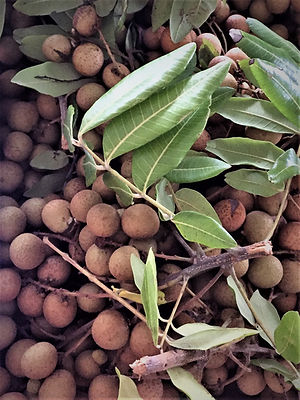Featuring local seasonal tropical fruit
OUR FRUITS
Passionfruit
Always popular for the tropical fruit tastings. Available most of the year although scarce in March, April and May and October. We get several varieties but the Panama Red, Panama Gold and Select Black are the most common.
Aside from being eaten straight out of the shell, they are commonly used in Australia as a topping for pavlovas and in icing for vanilla slice.
Known for their sweet and sometimes tart flavour they are highly aromatic and contain vitamin c, dietary fibre, vitamin B, niacin, iron and phosphorus.


Soursop
A flavour sweeter than you would imagine given the name! Like a mix between pineapple and strawberry or banana, with a hint of citrus.
Quite a large fruit, usually eaten raw but also used in smoothies.
Green skin with spikes hides the creamy white flesh inside. Significant amounts of vitamin c, vitamins b1 and b2.
Black Sapote
Well this one is hard to make look pretty on the plate! Eaten when very soft, it is closely related to the persimmon and also known as chocolate persimmon and chocolate pudding fruit - because it's said to taste like chocolate pudding.
Eaten as a dessert with cream and a touch of rum (is that just me?) or vanilla it can also made into chocolate mousse, muffins and cakes.
The black sapote is low in fat and contains about four times as much vitamin C as an average orange. It is also a good source of fibre and potassium.


Mangosteen
Known as "the queen of fruits"the white flesh is highly valued for its juice, delicate texture and slightly sweet and sour flavour.
Usually eaten raw straight out of the shell it is available during the summer months.
Rich in energy, protein, carbohydrates and fibre. Also containig essential nutrients calcium, iron, magnesium, phosphorous, potassium, sodium, zinc and vitamins C, B6, B12 and Vitamin A.
Pomelo
The largest of the citrus fruits usually weighing 1-2kg but can grow much larger. Pomelos have thick rind and the membranous material around the segments is bitter and usually discarded. Skin colour is generally light green, yellow or light pink and the flesh varies in colour from pale yellow to pink.
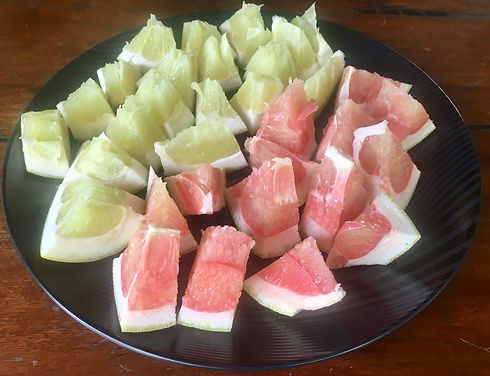

Rambutan
Whacky looking fruits we grow up here! A summer fruit this one always promotes interest at the fruit tastings.
A round/oval single seeded berry,the leathery skin is reddish or yellow and covered with fleshy pliable spines. the flesh is translucent and is white or pale pink with a sweet and mildly acidic flavour not unlike a grape. The rambutan is sweeter than the lychee.
Vitamin C, manganese and copper are about the only nutrients in rambutans, other nutrients (although present) are not in significant amounts.
Dragonfruit
Also known as pitaya or strawberry pear, it is available most of the year and the flesh is usually red or white, sometimes yellow.
This fruit is likened to a kiwi fruit because of it's mild sweet flesh and black crunchy seeds. The flesh is eaten raw and has a slightly nutty taste. The fruit can also be made into juice or wine and used to flavour beverages.
The fruits edible seeds contain heart healthy fats and omega-3 fatty acids. It also contains good amounts of Vitamin C and calcium.


Rollinia
Also known as Brazillian custard apple, wild sugar apple and biriba, this is a fast growing sun-loving tropical tree.
The flesh is very soft and sweet and tastes like a lemon meringue pie! With a short shelf life after picking this fruit is rarely seen outside areas of cultivation - most commonly seen at local markets.
It has more protein in it than almost any other kind of fruit. It is also an excellent source of calcium, phosphorous, iron and vitamin C.
Mango
Mangoes mean Aussie summer!! Sweet, juicy and aromatic. Varieties include R2E2, Kensington Pride, Bowen, Kent, Calypso, Asian Queen.
Delicious paired with chicken or prawn, used in summer salads, BBQ'd or in cocktails and smoothies, a popular flavour for cheesecake, icecream and yoghurt - we love them!
with a cup containing about 100 calories they have Vitamins A, C, B6 as well as fibre and folate.


Lychees
A rosy red inedible skin, semi-translucent flesh which is sweet, tangy and juicy. A summer fruit, popular in salads and desserts.
Lychees have high levels of B vitamins, as well as potassium, thiamin, niacin, folate, and copper.
custard apples
Also known as sugar apple and sweetsop. It is creamy, sweet and juicy and tastes a bit like custard mixed with apple and pear.
You'll find custard apples contain Vitamin C, are also high in potassium and magnesium and contain Vitamin A.


PINEAPPLE
The yellow flesh has a tropical flavour that is more sweet than tarts. Strictly speaking not fruit but 100-200 fruitlets all fused together!
Available all year round, they are eaten raw, added to salads, kebabs, juiced and BBQ'd.
Pineapple is an excellent source of manganese and vitamin c. It also contains trace amount of vitamins B1 and B6.
TOAD SKIN MELON
We don't think they're as ugly as our toads but we get why they're called toad skin melons!
Also known as Piel De Sapo or Christmas melons, they are supersweet and super juicy. Available most of the year, they taste like a mild honeydew.
Melons are a source of vitamins C, A, dietry fibre and calcium. They are also low in calories and sodium. They have very little fat and no cholesterol.


PAPAYA
Bright orange/red flesh, the ripe fruit is usually eaten without seeds or skin and is very sweet. Popular in Asian cuisine, unripe green fruit is added to salads and cooked in curries. The seeds are edible and have a sharp, spicy taste and can be ground and used in place of pepper.
Papaya contains a unique bundle of antioxidants - Vitams A & C, fibre, folate and cartenoids.
JABOTICABA
A slow growing evergreen that can reach heights of 15m It has a round thick skinned berry that resembles a round grape, with rosy pink or white gelatinous flesh containing 1-4 seeds.
The fresh fruit has a short shelf life and so these fruits are rarely seen outside of locals markets close to where they are grown. They are used to make jellies, jams and liqueurs.
They are a rich source of vitamin C and also contain other vitamins like vitamin E, thiamin, niacin, riboflavin and folic acid. Minerals like calcium, potassium, magnesium, iron, phosphorus, copper, manganese and zinc are also present in this fruit.

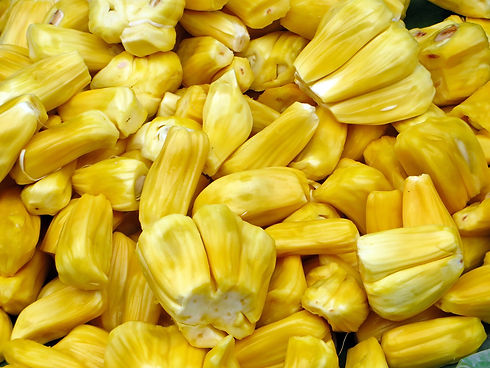
JACKFRUIT
Supposedly the largest tree-borne fruit in the world, fruit varies from 3kg to 30kg!
The sweet flavour is likened to a combination of apple, pineapple, mango and banana.
DACCAS
Did you know bananas are the worlds most consumed fruit?? Daccas are red bananas, smaller and plumper than Cavendish. When ripe the flesh is cream to light pink in colour and softer and sweeter than Cavandish, with a mango flavour - yummy!!
Containing 6 vitamins and 11 minerals, a banana gives an instant, sustained and substantial boost of energy.


STAR APPLE
The skin and rind is inedible. The flesh is sweet, juicy and tastes milky and jelly-like, smilar to a persimmon.
When the fruit is cut transversely, the seeds are seen to radiate outwardly from a central core, producing a star-shaped pattern.
They contain Vitamins C, B1, B2, B3 as well as iron and phosphorus
SAPODILLA
Actually a large berry, it has a furry skin a bit like kiwi fruit. It has a very sweet, caramel/malty flavour and a grainy texture, similar to a ripe pear.
Containing Vitamin C, Dietary Fibre, iron & copper.

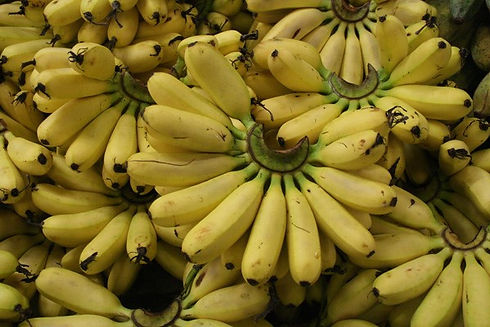
MONKEY BANANAS
Monkey bananas are small, firm, plump and rounded with very little curve. They are very sweet and keep well.
Rich in fibre, potassium, vitamins A, B6 and C, the health benefits of bananas are many.
CARAMBOLA
Starfruit or 5 star. Distinctive ridges running down its side, usually 5 but can vary. The skin has a waxy feel and the flesh is crunchy, firm, and extremely juicy. Texture is similar in consistency to grapes.
Star fruit contains good quantities of vitamin C, a good source of B-complex vitamins such as folates, riboflavin, and pyridoxine (vitamin B-6) and small amount of minerals and electrolytes like potassium, phosphorus, and zinc and iron
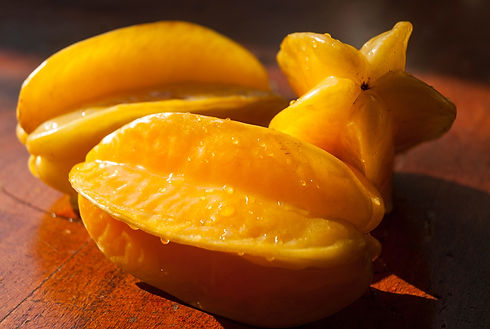

MAMEY SAPOTE
The fruit is a berry and the flesh colour ranges in colour from pink to orange to red. The skin has a texture between sandpaper and the fuzz on a peach. A peach/apricot flavour, fresh and frozen fruit is blended to make ice-creams & milkshakes.
High in vitamins C and B-6, as well as good amounts of potassium, vitamin E and copper.
LONGAN
Also known as Dragon Eye, this fruit is closely related to the Lychee and Rambutan. The flesh is sweet and juicy, slightly musky.
Longan fruit contains rich amounts of Vitamin C and A, and also contains minerals like iron, phosphorus, magnesium and potassium.
